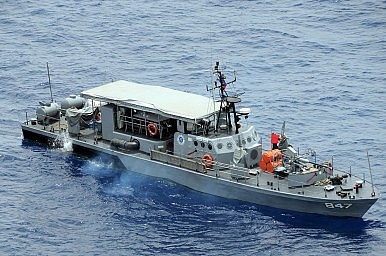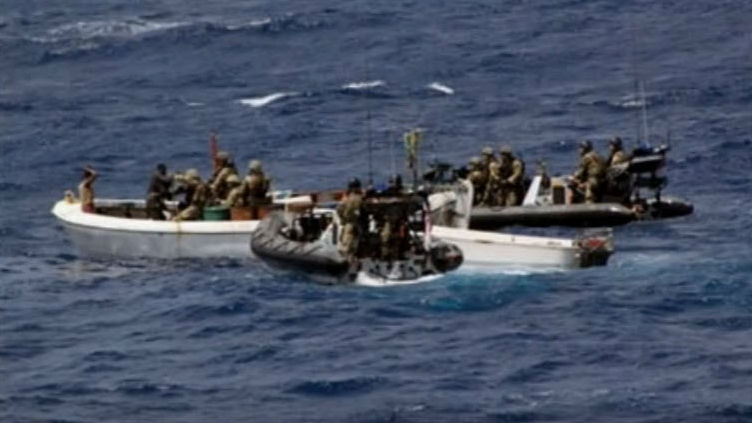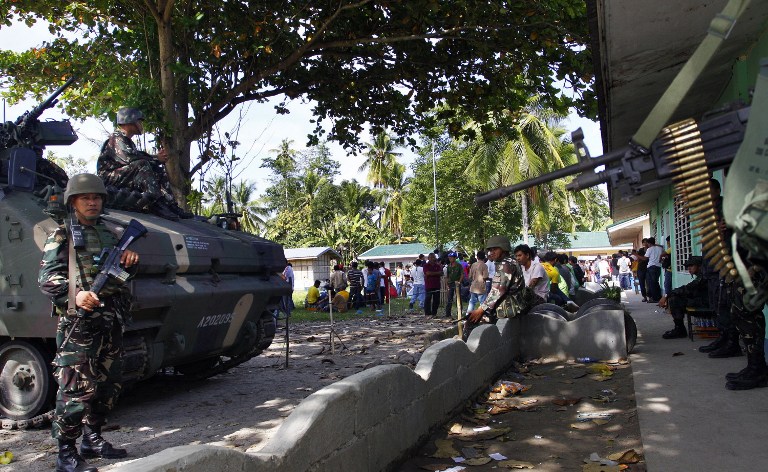From the Jakarta Post (May 4):
Who released the sailors? Untold story behind hostage rescue
 Ahmad Baedowi (left), one of the negotiators who helped in the release of 10 members of an Indonesian ship’s crew held hostage by the Abu Sayyaf group in Sulu, South Philippines, shakes hands with the ship’s crew coordinator Julian Philip in a jungle in Sulu on May 1, during the release process (Exclusive/thejakartapost.com)
On the heels of
the heart-warming return of 10 Indonesian sailors previously held hostage by
the Abu Sayyaf group in the southern Philippines, the details of the release
remain cloudy as the government seems reluctant to disclose the events that led
to the rescue.
Ahmad Baedowi (left), one of the negotiators who helped in the release of 10 members of an Indonesian ship’s crew held hostage by the Abu Sayyaf group in Sulu, South Philippines, shakes hands with the ship’s crew coordinator Julian Philip in a jungle in Sulu on May 1, during the release process (Exclusive/thejakartapost.com)
On the heels of
the heart-warming return of 10 Indonesian sailors previously held hostage by
the Abu Sayyaf group in the southern Philippines, the details of the release
remain cloudy as the government seems reluctant to disclose the events that led
to the rescue.
Following the
sailors' return, Foreign Minister Retno LP Marsudi asserted on
Monday that the release was made possible through intense coordination
with numerous parties, including Filipino authorities and the sailors'
employers, Patria Maritime Airlines.
However,
government officials have not revealed further details, including Coordinating
Political, Legal and Security Affairs Minister Luhut Pandjaitan, who refused to
name the groups and non-governmental parties involved in the rescue operation.
While some media
reports have named numerous public figures rumored to have led the process of
releasing the crewmen, several sources – who personally took part in the rescue
efforts but asked to remain anonymous due to the sensitivity of the information
and the safety of other four Indonesians still being held by another group –
told The Jakarta Post that the operation actually involved
more than just old-school diplomacy.
How much was
the ransom?
Sources have
confirmed that neither Indonesian officials nor the sailors' employer Patria
Maritime Lines paid a ransom demanded by the militant group.
The negotiations
instead comprised people-to-people dialogue, involving a respected figure from
the Moro National Liberation Front ( MNLF ), which was made possible due to a
friendly promise made by the Sukma Foundation's humanitarian team to provide
aid to support young generations of the Moro tribe in the Philippines.
The 60-year-old
MNLF senior commander, codenamed Grand Alpha, who headed 300 to 400 combatants
in the Sulu area, has helped the Sukma Foundation since the beginning of April,
when he assisted the humanitarian team to make contact with Tawing Humair, the
leader of the kidnappers who hijacked the Brahma 12 tugboat in March.
"Grand Alpha
said [to Tawing] that there is bigger opportunity than just transactions [...]
bigger opportunities for Moro people's future, education and welfare," the
source said, citing what happened during the negotiations.
The Indonesian
government mistakenly thought the crewmen had been kidnapped by Abu Sayyaf
commander Al Habsi Misaya, who was in fact handed the sailors after Tawing
Humair abandoned the hijacked tugboat on his way back from the Tawi-Tawi
islands.
Believing Al
Habsi was the kidnapper, an Indonesian negotiation team led by retired Army
general Kivlan Zein made efforts through contacting Nur Misuari, the founder of
the MNLF, who later appointed a subordinate named Tahir to negotiate with
Habsi.
Without Misuari's
knowledge, Tahir communicated with Grand Alpha, who said they should hold back
their troops and not make any offensive moves against the group as the
hostages' lives would be at risk.
Later, Grand
Alpha's team decided to step in to the rescue efforts as they knew the
Indonesian government had negotiated with the wrong party. They were afraid
that if a ransom was paid, the hostages would not be freed as there were a lot
of similar cases going on.
Meanwhile, Patria
Maritime Lines decided to pay the ransom of Rp 15 billion ( US$1.14 million )
for the hostages' release and brought the money to Zamboanga on April 29, but
Tawing refused to hand over the hostages to either the company or the
government due to the promise he made with Grand Alpha.
Tawing,
reportedly a 30-year-old madrasah ( Islamic school ) graduate, was said
to respect Grand Alpha as the senior militant had protected him and Moro
youngsters on several occasions. When Grand Alpha called him to negotiate the
release of the seaman, Tawing obeyed him reverently.
Promise of
humanitarian aid
Edo, not his
real name, MNLF member and a distant relation of Grand Alpha, who was also
present during the negotiations, said the idea of humanitarian assistance for
younger generations of Moro suddenly emerged as part of the trade-off in return
for releasing the hostages.
Even though the
commitment was still being questioned, Edo
said, Grand Alpha had convinced the militants and said Indonesian Muslims were
the only Asian neighbor that had good relations and could help Moro people with
a peace process, as well as educational assistance and other transformative
projects.
"The
negotiation team also said younger generations [of the Moro tribe] would have
the privilege of being sent to schools in Aceh," Edo
said.
The Sukma
Foundation, founded by media mogul Surya Paloh, helped child victims of the
Aceh tsunami by establishing the Sukma Bangsa school to ensure their access to
education, and therefore Moro people believed in it.
When the
government's negotiations reached a dead end, the Sukma Foundation's
humanitarian team contacted its deputy chairman Rerie L. Moerdijat to ensure
the continuance of the operation, a case in which she first consulted with
Surya. Later, she deployed a team in the Philippines to immediately help
rescue the hostages.
Under the
instruction of President Joko "Jokowi" Widodo, the team from Jakarta landed in
Manila on on Saturday evening and immediately met the Armed Forces of the
Philippines ( AFP ) and the Foreign Ministry.
 Ahmad Baedowi ( wearing glasses ), one of the negotiators who helped in the release of 10 members of an Indonesian ship’s crew held hostage by the Abu Sayyaf group in Sulu, South Philippines, shakes hands with a ship’s crew in a jungle in Sulu on May 1, during the release process ( thejakartapost.com/Exclusive )
Sunday’s surprise
release
Ahmad Baedowi ( wearing glasses ), one of the negotiators who helped in the release of 10 members of an Indonesian ship’s crew held hostage by the Abu Sayyaf group in Sulu, South Philippines, shakes hands with a ship’s crew in a jungle in Sulu on May 1, during the release process ( thejakartapost.com/Exclusive )
Sunday’s surprise
release
The team stood by
in Zamboanga from Saturday night and went down to Jolo, the capital of Sulu, at
around 5 a.m. local time on Sunday. They approached the
militant's camp located in the jungle at around 7 a.m. and waited for
about four hours until midday, when the sailors appeared safe and sound.
While the
negotiation team remained hidden, the sailors were brought by Grand Alpha
subordinates by car to the house of Sulu Governor Abdusakur Tan II, who had
been briefed about the hostages' arrival the night before. They were dropped
off near a gas station and told to walk directly to Tan II's house.
Julian Philip, a
hostage, said following his arrival at the Foreign Ministry office that the
sailors' release came as a surprise, telling the same story behind their sudden
arrival at the governor's house.
"We were
just suddenly put in a car, dropped off at a location and told to find the
governor's house," Julian said.
Following the
release, the sailors were transported by two Filipino police helicopters to an
airbase in Zamboanga, where they underwent verification and health checks,
before departing for Balikpapan and onwards to Jakarta on Surya's
private jet.
The 10 seamen
arrived at Halim Perdanakusumah
Airport in East Jakarta
around midnight on Sunday, with the assistance of NasDem Party deputy
chairman Victor B. Laiskodat and a counsellor from Indonesia's
embassy in the Philippines,
Eddy Mulya.
The government is
now focusing its attention on securing the release of four Indonesian sailors
who were taken captive later in April by another group demanding a ransom in
Sulu province, which did not have links with Tawing Humair.
 Coordinates denoting the location where 10 Indonesian ship crew were held hostage by the Abu Sayyaf group in Sulu, southern Philippines, were released on Sunday. A mobile device using a global positioning system ( GPS ) detected the location. ( JP/Exclusive )
Retno and Luhut
attended a meeting with Indonesian Military commander Gen. Gatot Nurmantyo and
National Intelligence Agency ( BIN ) chief Lt. Gen. ( ret ) Sutiyoso on
Monday at the Office of the Coordinating Political, Legal, and Security
Affairs Minister in Jakarta,
where they discussed intensifying coordination to release the four crewmen.
Coordinates denoting the location where 10 Indonesian ship crew were held hostage by the Abu Sayyaf group in Sulu, southern Philippines, were released on Sunday. A mobile device using a global positioning system ( GPS ) detected the location. ( JP/Exclusive )
Retno and Luhut
attended a meeting with Indonesian Military commander Gen. Gatot Nurmantyo and
National Intelligence Agency ( BIN ) chief Lt. Gen. ( ret ) Sutiyoso on
Monday at the Office of the Coordinating Political, Legal, and Security
Affairs Minister in Jakarta,
where they discussed intensifying coordination to release the four crewmen.
The sources said
the Sukma Foundation humanitarian team was not yet involved with the government
in the efforts of releasing the remaining four crewmen and would only come onto
the scene if Jakarta
failed in its attempts.
‘Snack
diplomacy’
With a successful
and safe release mainly due to civil society and humanitarian-based
negotiations, the government should begin to see that diplomacy can also be
effective at civil society level.
"Diplomacy
does not only mean that we should deploy ex-military generals or intelligence
officers; our civil society is also strong," one source said.
Samsu Rizal
Panggabean, a researcher from Gadjah Mada University ( UGM ) who is a
consultant with the Sukma Foundation, said the operation was made possible
through the bond between the Indonesians and local figures of the Moro tribe.
Not only did they
share the same Muslim faith, Samsu said, but Indonesian snacks, such as bakpia
cakes, tempeh chips and rempeyek crackers, as well as Indonesian
cigarettes that the team shared with the Moro people had touched their hearts.
When the Sukma
Foundation gave copies of the Koran not only to the Grand Alpha team but also
to Tawing Humair, they seemed moved and expressed their thanks.
“We met them as
friends. So it [the operation] was based on mutual trust,” Samsu said.
New hope
Edo said a
military offensive would not actually tackle the problem of extremism in the Philippines,
let alone annihilating Abu Sayyaf, as by using force, the younger generations
would instead bear more hatred toward the outside world.
Abu Sayyaf
members themselves are in fact sons of MNLF commanders who passed away during
the revolution.
Many MNLF and Abu
Sayyaf members are related by blood, but they have had different principles and
doctrines from the start, as the MNLF struggles for its rights of determination
while Abu Sayyaf leans toward extremism. The fact that they have family
relations makes the government mistakenly regard them as the same group.
Edo said
children in the Abu Sayyaf group were forced to replace their predecessors to
keep the leadership relay going because all branches of the militant group had
lost hope of entering mainstream society as they could be jailed without
dialogue or negotiations, and they are not offered amnesty.
"They want
to change their lives, but they are prompted to continue their terror because
they have no hope of going back to the mainstream government," Edo said, adding that the Filipino government should rework
its antiterrorism policy.
The fact that
Tawing and his compatriots were moved by the offer of education and
humanitarian assistance programs was due to the glimmer of hope of ending the
cycle of violence in the country, where the wives of rebels are forbidden from
visiting the city and children are not allowed to go to school, the source
added.
Rerie said over
the phone that the Sukma Foundation had released a statement on its involvement
as its role in the operation was being questioned.
“But the most
important thing is that the 10 sailors have returned safely to Indonesia,”
Rerie said.
http://www.thejakartapost.com/news/2016/05/04/who-released-the-sailors-untold-story-behind-hostage-rescue.html









